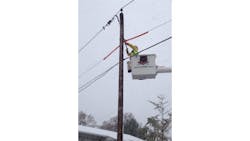New York Electrical Contractor Works Round the Clock to Restore Power and Functionality to the City's Infrastructure
As many of New York’s commercial and residential buildings remain closed — their mechanical and electrical systems destroyed by Hurricane Sandy’s flood waters — Long Island, N.Y.-based electrical contractor E-J Electric Installation Co. is working tirelessly to bring power and systems back to them. With divisions that include both transmission and distribution (T&D) and electrical construction, the firm is in a unique position to offer its services to the city.
“The storm surge washed out buildings on the coast, wherever the water was, including all around Manhattan and Brooklyn,” says Anthony E. Mann, president and CEO, E-J Electric Installation Co., Long Island City, N.Y. “The storm brought unprecedented damage to the infrastructure of New York.”
Since October 31, the firm has deployed its line division, including around 40 linemen, to help with power restoration efforts in Long Island, along with First Call, its emergency response team. “It’s created a demand where we’re getting calls every day, and there are places still where they’re just starting to pump out and assess the damage,” says Mann. “Our staff from in the field — from project management to engineering — has been working around the clock, even through the weekends.”
Currently, the company’s projects include two major hospitals, a 4,000-resident multifamily tower and New York City housing projects, and a sports facility where the entire electrical system was destroyed. The firm’s transit division is charged with assessing and working on the Staten Island Ferry.
Many of the projects the firm was working on before the storm, especially those downtown, have been put on hold. “They’re just now pumping out the water from the flooding down at the World Trade Center,” says Mann. “We’re just getting back in now. Also in that area, the transit facilities were closed, so we couldn’t do a lot of work on the transit facilities that we were working on.”
Fortunately, the firm’s headquarters were untouched by the rising waters and the building never lost power. “Our entire neighborhood was flooded, literally right up to 10 ft from our steps,” says Mann. “We were lucky, and that has enabled us to respond very quickly.”
Still, the company wasn’t completely untouched. Its warehouse, only two blocks away from headquarters, had 10 in. of water in it. Furthermore, many of the company’s employees were left without homes. “We have employees that lost everything — houses, cars, possessions — in the flooding and the fires that resulted from the flooding.”
The company is offering assistance to its employees. “There are additional resources available to them from FEMA, but we’re not waiting,” continues Mann. “These people have families, so they need to get back on their feet.”
Despite their own situations, members of the staff continue to respond to emergency situations. “Our workforce has been very responsive,” he explains. “We’ve had emergencies where we’ve needed up to 25 electricians in the facilities for an emergency, and they’ve come and worked through the night.”
With mass transit still out of commission and most of the gas stations in the city still out of service or with long lines, E-J Electric Installation Co. made a pilgrimage to Connecticut for hundreds of gallons of gasoline. It fills its service vehicles, and also gives its employees access to the fuel. “Our employees couldn’t get to work or anywhere else they needed to be because mass transit was shut down, roads were closed, and the gasoline shortage,” says Mann. “People have had to wait hours on line, so we went up to northern Connecticut and purchased hundreds of gallons of gasoline and put it in containers and brought it down for our vehicles as well as our employees’ vehicles.”
The out-of-state foray for gasoline was part of E-J Electric Installation Co.’s disaster plan. Before the storm, the firm circulated an updated preparedness plan, which includes the emergency contact list, cell phone numbers of its employees, and vendors’ emergency numbers. “We’ve had a lot of experience in this,” says Mann, who credits the firm’s membership with the Electrical Roundtable for this. In updating the plan, the firm took advantage of the experience of member Frischhertz Electric Co. in New Orleans. “They shared with us a lot of what went on during and after Hurricane Katrina, and that’s how we developed our disaster plan. That being said, no one expected the recovery to be the flooding that happened in the New York area. The storm surge was just unprecedented. We were prepared for other disasters, but the flooding has been very challenging for everybody.”
